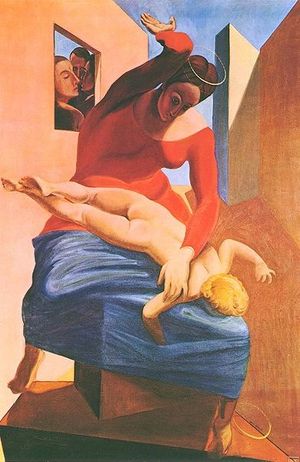The Virgin Spanking the Christ Child
The Virgin Spanking the Christ Child before Three Witnesses: Andre Breton, Paul Eluard, and the Painter (1926) is a painting by the German dadaist and surrealist painter and sculptor Max Ernst (1891-1976). It is one of the rare examples of spanking in painting.
It is one of Max Ernst's best known paintings, and one that led to heated discussions and accusations of blasphemy. The painting is usually not considered a work of caricature or satire, as such would contradict to the surrealist principles in which, simply speaking, the subconscious is permitted to show without a defined intended message.
The painting
The painting shows the Virgin Mary with the Christ child on her lap. The well-known standard motif from Christian iconography has been modified and transformed such that the Christ child does not sit as usual upright in her lap, but instead, the Virgin has laid the naked infant face down to spank his bare bottom with her open hand, raised high. The Christ child's nimbus has dropped to the floor.
In the background of the picture, three men are watching the scene from behind through a small window. These men are, as explained in the title of the painting, André Breton, the French writer who had written the "Surrealist Manifesto" of 1924, Paul Éluard, the French poet who was also one of the founders of the surrealist movement, and Max Ernst himself.
The motif of the spanked Christ child
The motif of the spanked Christ child is in fact much older than Ernst's painting. It is, for example, also featured in the English folk song The Bitter Withy.
Links
- The punishment of the Jesus Child. (discussion and a bigger version of the picture)
- Max Ernst's Blasphemy, an article by Leo Steinberg
Chat rooms • What links here • Copyright info • Contact information • Category:Root
